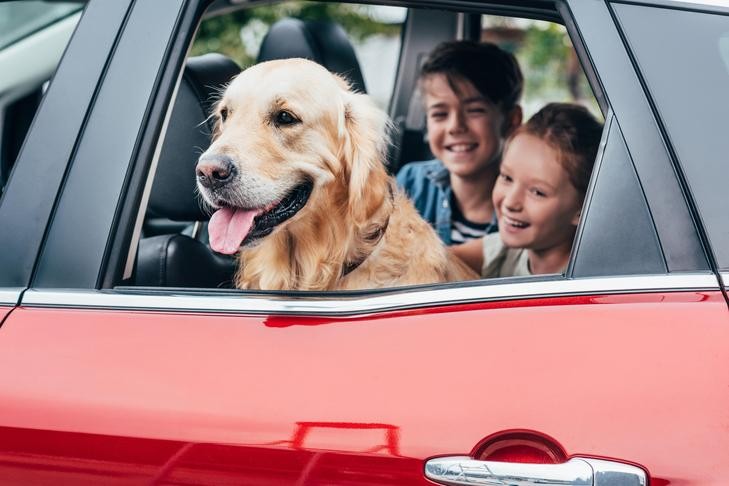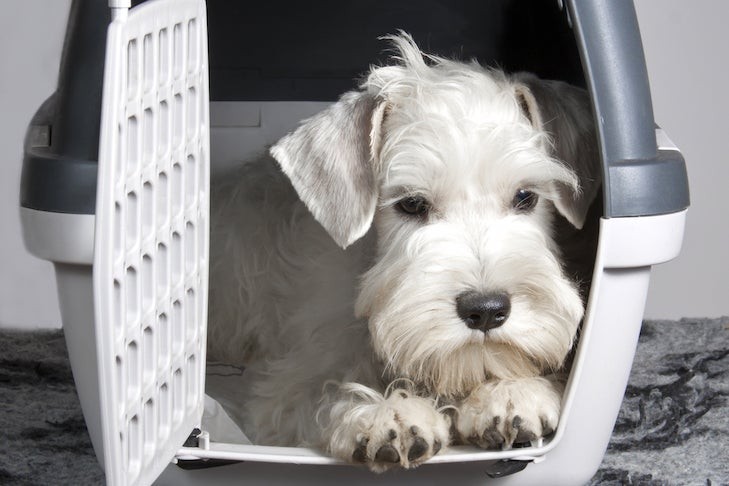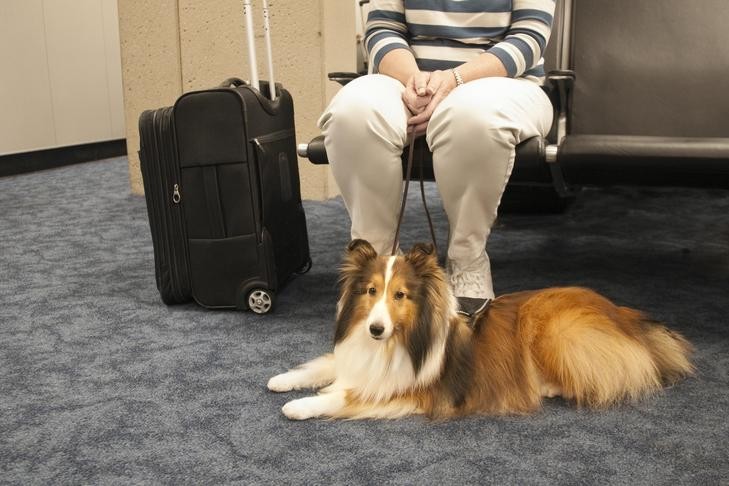Traveling with your furry friend can be an incredibly rewarding experience, creating lasting memories and strengthening your bond. At TRAVELS.EDU.VN, we understand that bringing your dog along on vacation requires careful planning and consideration. Let us guide you through the essential steps for a seamless and enjoyable journey, ensuring your canine companion’s comfort and safety every step of the way. Ready to book a dog-friendly trip? Contact TRAVELS.EDU.VN now for personalized advice and travel packages!
1. Pre-Trip Health and Safety Preparations
Before embarking on your adventure, your dog’s health and safety should be your top priority. A visit to the veterinarian is crucial for ensuring your pet is fit for travel.
1.1 Veterinary Check-up and Vaccinations
Schedule a check-up with your veterinarian well in advance of your trip. This appointment serves multiple purposes:
- Health Assessment: The vet will assess your dog’s overall health, ensuring they are physically and mentally prepared for the stresses of travel. Not all dogs enjoy traveling, so it’s important to confirm they are a good candidate.
- Vaccination Updates: Confirm that all vaccinations, including rabies, distemper, parvovirus, and adenovirus, are up-to-date. Obtain a copy of your dog’s vaccination records, as these may be required for airline travel or when crossing state lines.
- Health Certificate: Depending on your mode of transportation and destination, a health certificate may be required. This certificate, issued by a licensed veterinarian, confirms that your dog is free from contagious diseases and meets specific health requirements.
- Medication and Prescriptions: If your dog requires any medications, ensure you have an ample supply for the duration of your trip. Obtain prescriptions for any necessary refills, in case you need to replenish your supply while traveling.
- Parasite Prevention: Discuss parasite prevention with your veterinarian. Travel to new environments may expose your dog to different types of fleas, ticks, and heartworms. Ensure your dog is protected with appropriate preventative medications.
1.2 Emergency Preparedness
Even with the best planning, emergencies can arise. Being prepared can make all the difference in ensuring your dog’s well-being:
- Emergency Contact Information: Program the phone numbers of your regular veterinarian and a local 24-hour veterinary emergency hospital into your cell phone. If you’re traveling internationally, research veterinary services in your destination.
- First-Aid Kit: Assemble a pet-specific first-aid kit that includes essentials such as:
- Bandages and gauze
- Antiseptic wipes
- Sterile saline solution
- Tweezers
- Thermometer (rectal)
- Pet-safe pain medication (as recommended by your veterinarian)
- Benadryl (for allergic reactions, after consulting with your veterinarian)
- Emergency blanket
- Pet Insurance: Consider enrolling in pet insurance or travel insurance that covers veterinary expenses in case of illness or injury while traveling.
- Medical Records: Keep a copy of your dog’s medical records, including vaccination history, health certificates, and any relevant medical conditions, readily accessible.
1.3 Nutrition and Hydration
Maintaining your dog’s regular diet and ensuring adequate hydration are essential for their health and comfort during travel:
- Bring Familiar Food: Pack an ample supply of your dog’s regular food. Sudden changes in diet can lead to digestive upset, so it’s best to stick to what they know.
- Bottled Water: Carry bottled water for your dog, especially if you’re traveling to an area with questionable water quality.
- Travel Bowls: Use collapsible travel bowls for food and water. These are lightweight and easy to pack.
- Feeding Schedule: Maintain your dog’s regular feeding schedule as much as possible.
- Avoid Overfeeding: Be careful not to overfeed your dog, especially before or during travel, to minimize the risk of carsickness or digestive issues.
 Golden Retriever sitting in the backseat of a car with children.
Golden Retriever sitting in the backseat of a car with children.
2. Choosing the Right Travel Crate or Carrier
A secure and comfortable crate or carrier is essential for your dog’s safety and well-being during travel, especially when flying or traveling by car.
2.1 Crate Features and Requirements
When selecting a dog crate, consider the following features:
| Feature | Description |
|---|---|
| Size | Large enough for the dog to stand, turn around, and lie down comfortably. |
| Strength | Sturdy construction with handles and grips for easy carrying. |
| Ventilation | Adequate ventilation on all sides to ensure proper airflow. |
| Leak-proof Bottom | A leak-proof bottom with absorbent material to contain accidents. |
| Secure Closure | A secure latch or locking mechanism to prevent escape. |
| “Live Animal” Label | Clearly labeled with “Live Animal” and arrows indicating the upright position. |
| Identification | Include the owner’s name, address, and phone number on the crate. |
2.2 Airline Crate Requirements
If you’re flying with your dog, be sure to check the specific crate requirements of the airline you’re using. These requirements may include:
- Crate Size: The crate must be large enough for the dog to stand, turn around, and lie down comfortably, but not so large that the dog can be thrown around during turbulence.
- Crate Material: The crate must be made of rigid plastic or wood and be leak-proof and escape-proof.
- Ventilation: The crate must have ventilation on all four sides.
- Hardware: The crate must be assembled with metal hardware, not plastic.
- Food and Water: Attach food and water bowls to the inside of the crate.
- Identification: Clearly label the crate with your dog’s name, your name, address, and phone number, and emergency contact information.
- Health Certificate: You may need to provide a health certificate from your veterinarian.
2.3 Carrier Options for Small Dogs
For smaller dogs, a soft-sided carrier may be a more comfortable option. When choosing a carrier, look for the following features:
- Size: The carrier should be large enough for your dog to stand, turn around, and lie down comfortably.
- Ventilation: The carrier should have mesh panels for ventilation.
- Durability: The carrier should be made of durable material and have a sturdy frame.
- Comfort: The carrier should have a padded bottom for comfort.
- Secure Closure: The carrier should have a secure zipper or latch to prevent escape.
3. Identification is Key
In the unfortunate event that your dog gets lost during your travels, proper identification is crucial for a swift reunion.
3.1 Collar and Identification Tags
Ensure your dog wears a sturdy collar with the following information on the identification tags:
- Dog’s name
- Your name
- Your home phone number
- Proof of rabies vaccination
If you’re traveling for an extended period, consider adding a temporary tag with the location and phone number of your vacation spot.
3.2 Microchipping
Microchipping is a permanent form of identification that can significantly increase your chances of being reunited with your lost dog. A microchip is a small electronic device, about the size of a grain of rice, that is implanted under your dog’s skin. The microchip contains a unique identification number that can be read by a scanner at veterinary clinics and animal shelters.
Ensure that your dog’s microchip information is up-to-date with your current contact information.
3.3 Recent Photo
Carry a recent photo of your dog with you. This can be helpful in identifying your dog if they get lost.
 Sealyham Terrier laying down in a travel crate.
Sealyham Terrier laying down in a travel crate.
4. Traveling by Car with Your Canine Companion
Road trips with your dog can be a fantastic experience, but it’s essential to prioritize their safety and comfort.
4.1 Car Safety Restraints
Just like humans, dogs should be properly restrained in a vehicle to prevent injury in the event of an accident. Several options are available:
- Dog Seatbelts: These attach to your car’s seatbelt system and secure your dog in place.
- Car Seats: Designed for smaller dogs, car seats provide a secure and comfortable space while elevating them for better visibility.
- Safety Harnesses: These harnesses attach to your car’s seatbelt system and distribute the force of impact in an accident more evenly than a collar alone.
4.2 Creating a Comfortable Environment
Ensure your dog’s comfort by:
- Ventilation: Keep the car well-ventilated to maintain a comfortable temperature.
- Temperature Control: Avoid extreme temperatures in the car. Never leave your dog unattended in a closed vehicle, especially in hot weather. The American Veterinary Medical Association (AVMA) states that the temperature inside a car can rise rapidly, even on a moderately warm day, potentially leading to heatstroke and death.
- Frequent Breaks: Stop frequently for exercise and potty breaks.
- Water Availability: Always have fresh water available for your dog.
4.3 Preventing Carsickness
Carsickness can be a common problem for dogs. To minimize the risk:
- Empty Stomach: Avoid feeding your dog a large meal before traveling.
- Motion Sickness Medication: Consult your veterinarian about motion sickness medication for your dog.
- Fresh Air: Ensure good ventilation in the car.
- Frequent Stops: Make frequent stops to allow your dog to get fresh air and stretch their legs.
- Acclimation: Gradually acclimate your dog to car rides by starting with short trips and gradually increasing the duration.
5. Flying with Dogs: Navigating the Skies
Flying with your dog requires careful planning and adherence to airline regulations.
5.1 Airline Regulations and Restrictions
Each airline has its own specific regulations for traveling with animals. Contact the airline directly to inquire about:
- Pet Policies: Understand the airline’s policies regarding pet carriers, weight restrictions, breed restrictions, and required documentation.
- Reservations: Make reservations for your dog well in advance, as there are often restrictions on the number of animals permitted on each flight.
- Health Certificates: Determine if a health certificate is required for your dog to fly.
- Fees: Inquire about any fees associated with traveling with your dog.
5.2 In-Cabin vs. Cargo Travel
Dogs may travel in the cabin with you or in the cargo hold, depending on their size and the airline’s policies.
- In-Cabin: Smaller dogs that fit comfortably in a carrier under the seat in front of you may be allowed to travel in the cabin.
- Cargo: Larger dogs that do not meet the in-cabin size requirements must travel in the cargo hold.
Traveling in the cargo hold can be stressful for dogs. Consider the potential risks and benefits carefully before making a decision.
5.3 Preparing Your Dog for Air Travel
- Acclimation to Crate: Acclimate your dog to their crate well in advance of the flight. Make the crate a positive and comfortable space by feeding them meals inside and providing them with their favorite toys.
- Exercise: Ensure your dog gets plenty of exercise before the flight to help them relax during the journey.
- Potty Break: Allow your dog to relieve themselves immediately before boarding the flight.
- Sedation: Consult your veterinarian about whether sedation is appropriate for your dog during air travel. Sedation can help reduce anxiety, but it also carries potential risks.
 Shetland Sheepdog service dog laying next to its owner at the airport.
Shetland Sheepdog service dog laying next to its owner at the airport.
6. Alternative Modes of Transportation
While car and air travel are the most common options, other modes of transportation may be available, depending on your destination and your dog’s temperament.
6.1 Train Travel
Amtrak allows small dogs (under 20 pounds) on certain routes, but restrictions apply. Only one pet per passenger is allowed, and the pet must remain in a carrier under the seat for the duration of the trip. Visit the Amtrak website for detailed information on their pet policy.
6.2 Bus Travel
Most interstate bus companies, such as Greyhound, do not allow pets on board. Service dogs are an exception. Check with local bus companies for their specific policies.
6.3 Cruise Travel
Some cruise lines allow pets on board, but restrictions and fees may apply. Check with the cruise line directly for their pet policies. Cunard’s Queen Mary 2, for example, is known for its transatlantic crossings that welcome pets.
7. Essential Tips for a Smooth Trip
Regardless of your chosen mode of transportation, these tips will help ensure a smoother and more enjoyable trip for you and your dog.
7.1 Potty Breaks and Hygiene
- Frequent Breaks: Plan for frequent potty breaks, especially during long car rides or flights.
- Surface Training: Train your dog to relieve themselves on various surfaces, such as grass, concrete, and gravel, to accommodate different environments.
- Poop Bags: Always carry poop bags to clean up after your dog.
- Hygiene Wipes: Pack pet-friendly hygiene wipes for cleaning paws and fur after potty breaks.
7.2 Entertainment and Comfort
- Familiar Toys: Bring a few of your dog’s favorite toys to provide comfort and entertainment.
- Puzzle Toys: Puzzle toys can help keep your dog occupied and mentally stimulated during travel.
- Comfort Items: Pack a familiar blanket or bed to provide a sense of security.
7.3 Dog-Friendly Accommodation
Finding dog-friendly accommodation is key to a relaxing trip.
7.3.1 Researching Pet-Friendly Hotels
Before booking, confirm the hotel’s pet policy. Websites like BringFido and PetsWelcome can help you find dog-friendly hotels, motels, and vacation rentals.
Also, consider these points:
- Pet Fees: Many hotels charge pet fees, which can vary widely. Be sure to factor this into your budget.
- Size and Breed Restrictions: Some hotels have size and breed restrictions.
- Amenities: Look for hotels with pet-friendly amenities, such as dog parks, walking trails, or pet-sitting services.
7.3.2 Hotel Etiquette
- Respect Other Guests: Keep your dog as quiet as possible and avoid leaving them unattended in your room.
- Designated Areas: Ask hotel management where you should walk your dog and always clean up after them.
- Protect the Property: Use protective covers on furniture if your dog is likely to shed or drool.
7.3.3 Puppy-Proofing
Before letting your dog explore your accommodation, take steps to puppy-proof the space:
- Electrical Cords: Keep electrical cords out of reach.
- Hazardous Materials: Ensure that cleaning supplies and other hazardous materials are stored safely.
- Small Objects: Remove any small objects that your dog could swallow.
7.4 Stress Management
Traveling can be stressful for both you and your dog. A calm owner usually has a calm pet. If you’re nervous and uptight, your dog may pick up on your stress and become anxious.
- Stay Calm: Maintain a calm and confident demeanor.
- Positive Reinforcement: Use positive reinforcement to reward your dog for good behavior.
- Familiar Routine: Stick to your dog’s familiar routine as much as possible.
Remember that some dogs don’t enjoy traveling, and your dog may be happier staying home with a trusted pet sitter.
8. Frequently Asked Questions (FAQs)
1. What documents do I need to travel with my dog?
Depending on your mode of transportation and destination, you may need a health certificate, vaccination records, and proof of rabies vaccination. Check with the airline, train company, or border control for specific requirements.
2. Is it safe to sedate my dog for travel?
Sedation can help reduce anxiety during travel, but it also carries potential risks. Consult your veterinarian to determine if sedation is appropriate for your dog.
3. How can I prevent carsickness in my dog?
To prevent carsickness, avoid feeding your dog a large meal before traveling, ensure good ventilation, and make frequent stops. Consult your veterinarian about motion sickness medication.
4. What should I pack in my dog’s travel kit?
Pack your dog’s regular food, water, travel bowls, leash, collar, identification tags, health certificate, vaccination records, poop bags, hygiene wipes, familiar toys, comfort items, and any necessary medications.
5. How can I find dog-friendly hotels?
Use websites like BringFido and PetsWelcome to find dog-friendly hotels, motels, and vacation rentals.
6. What should I do if my dog gets lost during travel?
Immediately contact local animal shelters, veterinary clinics, and police departments. Post flyers with your dog’s photo and contact information. Use social media to spread the word.
7. Are there any breed restrictions for air travel?
Some airlines have breed restrictions for air travel, particularly for brachycephalic (short-nosed) breeds, which are more prone to breathing problems at high altitudes. Check with the airline for specific restrictions.
8. Can my dog sit on my lap during a flight?
Most airlines do not allow dogs to sit on passengers’ laps during flights. Dogs must remain in a carrier under the seat in front of you.
9. What are the rules for traveling with a service dog?
Service dogs are generally allowed to travel in the cabin with their handlers on airlines and trains. They are exempt from certain restrictions that apply to other pets. However, you may need to provide documentation to verify your dog’s service animal status.
10. How early should I arrive at the airport when traveling with my dog?
Arrive at the airport at least 2-3 hours before your scheduled departure time to allow ample time for check-in and security procedures.
9. Discover Napa Valley with Your Dog: A Tail-Wagging Adventure Awaits
Napa Valley isn’t just for wine enthusiasts; it’s a fantastic destination for dog lovers too! Imagine strolling through picturesque vineyards, enjoying outdoor dining with your furry friend by your side, and exploring dog-friendly parks. At TRAVELS.EDU.VN, we specialize in creating unforgettable Napa Valley experiences for you and your canine companion.
Here’s a glimpse of what awaits you:
- Dog-Friendly Wineries: Many Napa Valley wineries welcome well-behaved dogs on their outdoor patios and grounds. Enjoy a tasting while your pup relaxes by your side. Check out wineries like V. Sattui Winery and Castello di Amorosa, which are known for their dog-friendly atmosphere.
- Outdoor Dining: Savor delicious meals at restaurants with dog-friendly patios. Many Napa Valley restaurants offer water bowls and treats for your furry friend.
- Parks and Recreation: Explore Napa Valley’s beautiful parks and trails with your dog. Skyline Wilderness Park offers scenic hiking trails with stunning views.
- Dog-Friendly Accommodation: Choose from a range of dog-friendly hotels and vacation rentals in Napa Valley.
Let TRAVELS.EDU.VN curate the perfect Napa Valley getaway for you and your dog. We’ll handle all the details, from booking dog-friendly accommodation to arranging winery tours and recommending the best dog-friendly activities. Contact us today to start planning your tail-wagging adventure!
Ready to embark on an unforgettable journey with your dog?
At TRAVELS.EDU.VN, we understand the unique bond you share with your furry companion, and we’re dedicated to making your travel dreams a reality. Let us handle the complexities of planning a pet-friendly vacation, so you can focus on creating lasting memories with your beloved dog.
Contact TRAVELS.EDU.VN today for personalized assistance:
- Address: 123 Main St, Napa, CA 94559, United States
- WhatsApp: +1 (707) 257-5400
- Website: TRAVELS.EDU.VN
Let’s make your next adventure a truly unforgettable experience for both you and your four-legged friend. At travels.edu.vn, we believe that every journey is better with a dog by your side.
